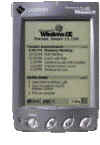Off The Shelf and In Your Palm
|
Palm-size PC's Built-in Applications The Casio E-10 and all other Palm-size PCs have the same set of Windows CE applications built into them. As a stand-alone product without any additional software, the Palm-size PC is a very functional unit. Below is a brief description of the built-in applications. For a more complete description see the sidebar below. You can also go to Microsoft's Palm-size PC Web page: http://www.microsoft.com/windowsce/ppc/about/default.htm
|
Bonus Software on CD ROM* bFAX Express (BSQUARE DEVELOPMENT; Fax: 888-266-2329; Web: http://www.bsquare.com). bFAX Express adds fax capability to the E-10 or any Palm-size PC. bFAX gives you the option of sending a standard cover page. You can compose a message on the cover page and send simple, one-page faxes, or add attachment documents composed in another application. Faxes can be sent from any Palm-size PC equipped with a CompactFlash card modem (see Screen 1). * Camera Viewer (Casio; Web: http://www.casiohpc.com/) Camera Viewer lets you view digital photos you take with a Casio digital camera. Transfer of these images from the camera to the E-10 should be easy because the E-10 and most of the Casio digital cameras have CompactFlash card slots. I had no images to test with this one. * Financial Consultant (LandWare; Phone: 201-261-7944; Web: http://www.landware.com) An easy-to-use financial calculator that lets you solve problems relating to Time and Money, Amortization, Effective and Nominal interest rates, Flexible compounding, Date calculations, Investment analysis, Retail-style percentage calculations, and more. The use of popup menus provides single tap access to over 90 functions while still maintaining an uncluttered interface. * Find File (Casio; Web: http://www.casiohpc.com/) The Find feature built into the Palm-size PC lets you search for a name, phone number, or phrase in your data. Find File adds the ability to look for data files by name, or display a "file tree." Tap on the small plus sign to the left of any folder in the tree to display its contents. Tap again (this time on the small minus sign) to close the folder. This utility is good for those of us who still relate to these devices in terms of file names and folders. (Tip 1: If you have the tree view open to a particular file and then go to another application and delete it, the file will remain in the tree view until you close and open the folder. Tip 2: Tap on any file in the tree view to open it. If it's a document, it will open in the correct application. If it's a program or utility, it will start.) (see Screen 2) * Meeting Minder (Casio; Web: http://www.casiohpc.com/) According to the self-description, this one "provides fast and easy outline organizing capabilities and an intuitive, drag-and-drop outline processor." Unfortunately, I couldn't figure out how to use it. The Help screen described all the features thoroughly. They need to add a step-by-step example of a typical use (like they did with the Find File program). * Quicken ExpensAble (On The Go Software; Phone: 800-331-3416; Web: http://www.onthegosoftware.com). Well designed for the Palm-size PC, Quicken ExpensAble lets mobile professionals track business-related expenses. It uses an "envelope" metaphor to track each trip (or event) you attend. It's easy to use and has pull-down menus where necessary to speed up data entry (see Screen 3). * smART Commander (ART Phone: 818-678-3999; Web: http://www.artcomp.com) Adds voice command capability to your E-10, letting you program an application or specific document to open when you speak the word of your choice. Tap on the smART Commander icon in the task tray, speak the word and you're in business. I don't like having to take out my stylus, tap the icon, and then speak out the command. Fortunately, you can reprogram the buttons on the E-10 (tap on Start, Settings, Buttons, Program). I'd assign smART Commander to the Side Button. This one activates Voice Recorder, but I don't use that much. Then all I have to do is slip the E-10 out of my pocket, press the button and speak out! * Tetris (MobileSoft, Web: http://www.mobilesoft.com). In years past I've "invested" a lot of time in Tetris (or one of its many clones). The version that comes with the E-10 is a licensed version of the original, from MobileSoft. It's free, but the installation procedure requires that you fill out a registration form and have your desktop PC linked to the Internet while you install. A little confusing, but it worked (see Screen 4). You can tap the screen to move or rotate the falling blocks. You can also use the rocker arm on the left side of the E-10 to move and rotate blocks, for one-handed play. Who needs a GameBoy when you've got a Palm-size PC? Screen 1: bFAX Express lets you send faxes from a Cassiopeia E-10, using an optional modem card.Screen 2: Find File utility lets you look for files by name or display the files on your E-10 in a file tree structure.Screen 3: Quicken ExpensAble lets you track expenses, write expense reports, and keep an eye on reimbursement checks.Screen 4: Casio teams up with MobileSoft to add the popular Tetris game to your E-10, free of charge. |
Copyright © Thaddeus Computing Inc.

